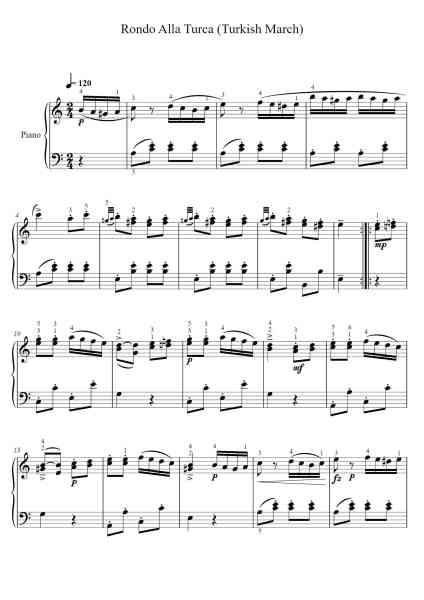
Piano Sonata No. 11 in A Major, K. 331: III. Rondo alla turca (Turkish March)
Wolfgang Amadeus Mozart
476 देखे गए

Rondo Alla Turca "Turkish March" from Piano Sonata No. 11 in A Major, K. 331: III. Allegretto "Section A with LH constant Rhythm"
Wolfgang Amadeus Mozart
424 देखे गए

Rondo Alla Turca (Turkish March) - Piano Sonata No. 11 in A Major, K. 331: III. Allegretto
Wolfgang Amadeus Mozart
371 देखे गए
Roblox Sheet

Roblox Sheet
Rondo Alla Turca "Turkish March" - Easy Version
Wolfgang Amadeus Mozart
Rondo Alla Turca "Turkish March" - Easy Version को Wolfgang Amadeus Mozart द्वारा एक नए तरीके से अनुभव करें! अपने कीबोर्ड का उपयोग करके Rondo Alla Turca "Turkish March" - Easy Version Roblox पियानो शीट्स वर्चुअल कीबोर्ड पियानो पर खेलें। चाहे आप एक Roblox पियानो गेम खिलाड़ी हों या क्लासिक टुकड़ों का अभ्यास करना चाहते हों, यह Rondo Alla Turca "Turkish March" - Easy Version Roblox पियानो शीट आपके लिए आदर्श है, जिससे शुरुआती से विशेषज्ञ तक की प्रगति करना आसान है। Rondo Alla Turca "Turkish March" - Easy Version TOP 100 Roblox पियानो शीट्स में शामिल है, साथ ही कई अन्य आसान, क्लासिकल, पॉप, क्रिसमस गाने और डिज़्नी संग्रह भी हैं जो आप खेल सकते हैं!
365 देखे गए

Piano Sonata No. 11 in A Major, K. 331: III. Rondo Alla Turca (Turkish March)
Wolfgang Amadeus Mozart
363 देखे गए

Rondo Alla Turca "Turkish March" from Piano Sonata No. 11 in A Major, K. 331
W. A. Mozart
344 देखे गए

Sonata No. 11 in A Major, K. 331: III. Rondo Alla Turca (Turkish March) - Allegretto
Wolfgang Amadeus Mozart
341 देखे गए

Rondo Alla Turca (Turkish March) in A Major, K. 331: III. Allegretto
Wolfgang Amadeus Mozart
314 देखे गए

Rondo Alla Turca "Turkish March" in A Minor, K. 331: III. Allegretto
Wolfgang Amadeus Mozart
278 देखे गए

Rondo Alla Turca - Turkish March in A Major, K. 331: III. Allegretto
Wolfgang Amadeus Mozart
269 देखे गए

Rondo Alla Turca (Turkish March) in A Minor, K. 331: III. Allegretto
Wolfgang Amadeus Mozart
253 देखे गए

Piano Sonata No. 11 in A Major, K. 331: III. Rondo alla Turca (Turkish March)
Wolfgang Amadeus Mozart
252 देखे गए








